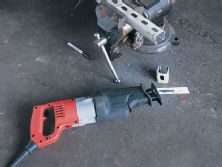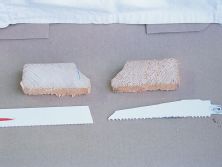Every shop worth its Snap-On® calendar has a collection of tools of mass destruction--chisels, pry bars, saws, hammers, BFHs--if it can be used to move, remove or break something, it will be needed sooner or later. To build a car, one must first take a car apart. Sometimes a part of the car one doesn't need is attaching a part one wants to something big. Or, there is an inconvenient relationship between two wanted parts. Or, a part is hidden inside a larger piece of material. Not everything one wants to add to a car bolts on, or comes fit to size. That's when we cut.
The best power tools combine a lot of horsepower with even more finesse. There are many methods of cutting available at many points in the cost/horsepower/finesse space. As horsepower or finesse is increased, cost tends to increase as well. It's easy to imagine a shop with many of them: upright and horizontal bandsaws, a plasma cutter, an oxy-fuel torch, a hacksaw, an air chisel, an axe, a Sawzall®...
A Milwaukee Electric Sawzall, though not inexpensive for a handheld power tool, is more affordable than some alternatives. It seems at first to come down more on the horsepower side of the balance, but when finesse is developed, it can achieve surprising precision. Tubing, channel, sheet, bars, lumber, tree branches, fenders, engine mounts, radiator hoses, tires, roofs, roll cages, wiring harnesses, brake lines, fuel lines...the Sawzall really will cut it all. If you're just starting out, and want to buy only one power saw for your shop, the oft-imitated Sawzall is a great choice.
With 110-volt AC choices from 6.5 amps to 11 amps and an 18-volt DC rechargeable option, there is a Sawzall for almost everybody. When the time finally came to buy a Sawzall for my own shop, I chose the biggest, baddest, mofo-in'est Sawzall of them all, the 11-amp Orbiting Super Sawzall. Horsepower is good. In the case of Sawzalls, more power brings with it a longer blade stroke (1 1/4 in. versus 3/4 in. for the smallest model) and higher maximum stroke speed (3200 spm versus 2600 spm for the smallest model). Just like automotive horsepower, the maximum may rarely be used, but when it's needed, you want to have it.
Only the most basic Sawzall doesn't have Milwaukee's Quik-Lok™ clamp, which releases the blade simply by turning a sleeve 90 degrees. More powerful models have a clutch that slips to protect the gears in the event the blade is jammed in the material and stops suddenly. Features unique to the 11-amp model are a counter-balanced mechanism to reduce vibration and orbital blade action, which lifts the blade on the reverse stroke for faster cutting. The latter can be adjusted continuously from zero to maximum.
The more you pay, the more you get. If you plan to use your Sawzall forever, as I do, you'll probably want to invest in the beefiest one that will handle the toughest tasks and take the most abuse. On the other hand, if you decide you'll want to use your Sawzall in wrecking yards frequently, the 18 VDC, rechargeable, battery-powered model is the one for you.


